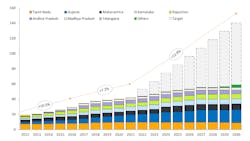Repowering could revitalize India’s wind sector as auctions drive investments
Offshore staff
INDIA — India has an ambitious 140-GW target for installed offshore and onshore wind capacity by 2030, which it stands to fall remarkably short of at present, according to a recent Rystad Energy report.
The compound annual growth rate for the wind sector has been only about 7.9% for the past five years, and India’s current installed wind capacity is only about 40.2 GW. As such, the country would require adding about 11 GW each year until 2030 to reach its target.
Rystad Energy expects about 1.8 GW of onshore wind capacity to be installed this year across India, thus even the target for this technology set for 2022 year-end of 60 GW (installed wind capacity) is likely to be missed.
However, as long as wind-focused and hybrid auctions continue driving the project pipeline and installations in India, repowering the country’s roughly 4.4 GW of onshore turbines—which were installed before 2007 and have capacities of less than 1 MW—could help revitalize the wind sector and meet targets.
India’s Ministry of Power released in July the long-term growth trajectory for renewable purchase obligations (RPO), which mandate that all electricity distribution licenses should purchase or produce a minimum specified quantity of their requirements from renewables. As such, states in India would need to meet a quarter of their individual energy demand from renewables under the new RPO mandate, a requirement which then increases to 43% by the end of this decade, Rystad said.
Offshore wind
The government of India's Ministry of New and Renewable Energy (MNRE) has set a target of 5 GW of offshore wind installations by 2022 and 30 GW by 2030, which has been issued to give confidence to the project developers in India market.
According to a recent Institute for Energy Economics & Financial Analysis (IEEFA) report, "India came up with its offshore wind power policy in 2015, but no projects have taken off since then, primarily because it costs significantly higher than solar and onshore wind. Despite the higher costs today, offshore wind is an important resource for decarbonizing India’s power sector. The country has the potential to generate 140 GW of electricity from offshore wind along its 7,600-km coastline. Half of this potential is near the coasts of Tamil Nadu and Gujarat."
The MNRE recently announced a mega 4-GW tender for offshore wind power off the coasts of Tamil Nadu and Gujarat in the next few months.
"Offshore wind could deliver utilization factors of more than 50-55% with a better wind resource profile in deep oceans. These are materially higher than its onshore counterpart that can reach up to 30-35%," the IEEFA report stated. "Further, India’s wind generation profile, peaking between evening and early morning hours, is complementary to solar, peaking during the afternoon. Therefore, adding offshore wind to the generation mix would potentially provide India with a better round-the-clock clean power resource and add resource diversification benefits."
According to IEEFA, India needs to develop its local supply chain, logistics and port infrastructure to obtain offshore wind's full potential.
There are currently 17 offshore India wind farms, which can be viewed on the 4C Offshore website. Owners include Tata Power, ONGC, Greenshore Energy, Bharat Light & Power, Suzlon Energy and MNRE.
10.05.2022



